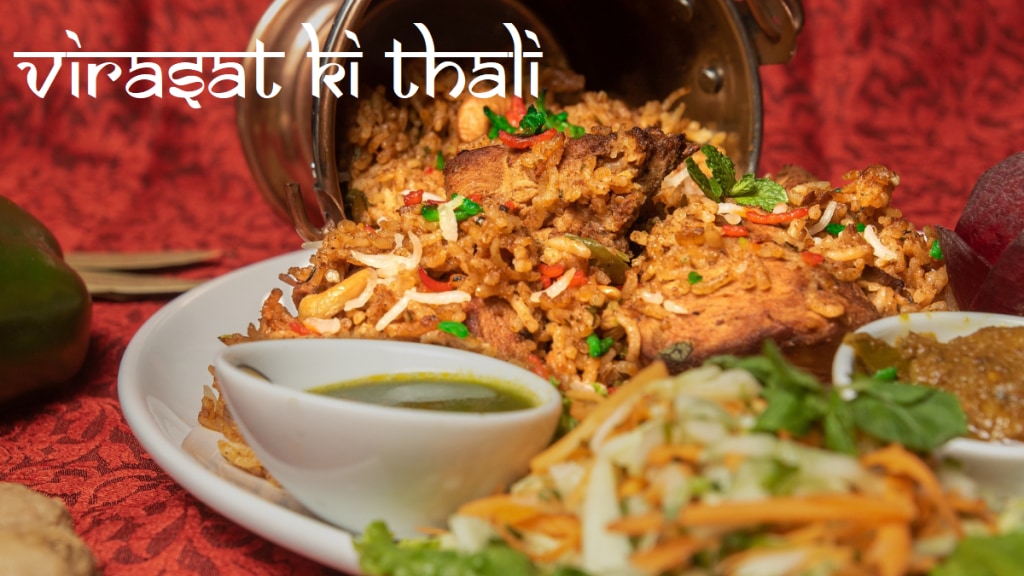Welcome to the first edition of ‘Virasat Ki Thali’, a month-long series that aims to delve into the rich tapestry of culinary traditions in India and explore the stories behind iconic dishes. In this inaugural edition, we embark on a tantalizing journey through time to uncover the captivating history of biryani, a dish that has evolved into a symbol of cultural diversity and culinary finesse. We will also guide you to some of the best spots in India where you can savor the authentic flavors of this legendary delicacy.
Do you know what is the most popular dish ordered on Zomato and Swiggy? It’s your favourite Biryani. In fact, in 2021, biryani was ordered every 2 seconds on Zomato and Swiggy!
You must have been a part of the whole argument of which biryani is better–is it Lucknowi or is it Hyderabadi? But deep within we all are united by the love we share for biryani because it’s not just a dish, its an emotion.
With its aromatic spices, fragrant rice, and succulent meat, biryani has captured the hearts and taste buds of millions across the country. But have you ever wondered how this exquisite culinary masterpiece made its way to India and evolved into its current form?
As we celebrated the first ever world biryani day, here’s the tale of the legacy, here the tale of the virasat that has trespassed boundaries. This is the story of biriyani…..
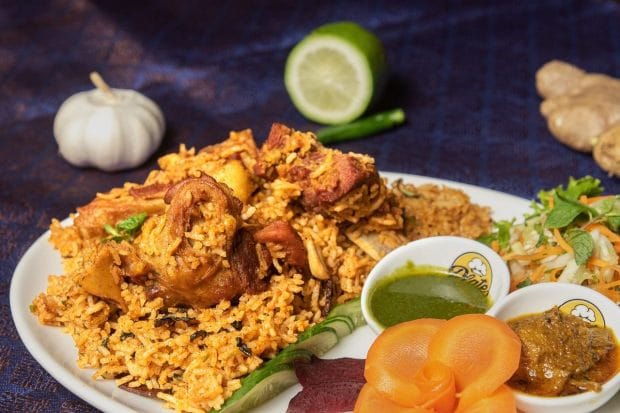
Speculations around its origin
There are so many speculations behind its origin. Some historians believe that biryani has its roots in faraway lands. Derived from the Persian words “Birian” (meaning ‘fried before cooking’) and “Birinj” (meaning ‘rice’), the term “biryani” itself reveals its foreign origins. While the exact path biryani took to reach India remains shrouded in mystery, historians and legends offer captivating tales that shed light on its journey.
But there are some who claim that it actually traces its origins back to Sanskrit, indicating its deep Indian connection. In ancient India, the early version of biryani, consisting of meat, rice, and spices, was known as “मांसोदन” (Maansodan). The dish was a testament to the culinary expertise and diverse flavors found in the region.
According to Mayrhofer’s “Etymological Dictionary of Old Indo Aryan,” the word “Birinj” can be traced back to the Sanskrit word “vrīhí” (व्रीहि), which refers to rice.
How did it become a part of Indian culture?
Mumtaz’s Inspiration
The origins of biryani can be traced back centuries ago, amidst the opulence of the Mughal era in India. Legend has it that biriyani was brought to the Indian subcontinent by the Mughal emperors who were renowned for their love of fine cuisine. Influenced by the Persian dish “pilaf,” they transformed it into a masterpiece by incorporating aromatic Indian spices and local ingredients.
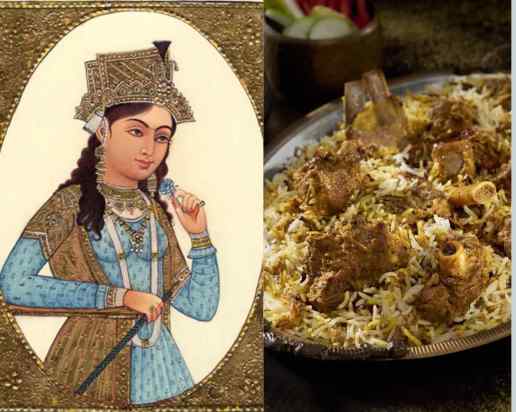
This story is surely one of the most believed tale behind the origin of our favourite dish
It is said that in the Mughal era, another anecdote adds to the biryani’s colorful history. Legend has it that Mumtaz, the beloved wife of Emperor Shah Jahan, discovered the Mughal soldiers looking weak and undernourished during her visit to the army barracks. In response, she urged the chef to create a special dish that combined meat and rice to provide balanced nutrition to the soldiers. The result was biryani, a flavorful concoction of rice, meat, aromatic spices, and saffron, cooked over a wood fire.
Other stories are also there
Legend of Timur’s Army:
One such story takes us back to the year 1398, when the Turk-Mongol conqueror Timur arrived at the Indian frontiers. It is said that Timur’s army carried with them a precursor to biryani as their war campaign diet. The soldiers would bury an earthen pot filled with rice, spices, and whatever meat was available in a hot pit. After a while, the pot would be unearthed, revealing a flavorful meal that nourished the warriors amidst their conquests.
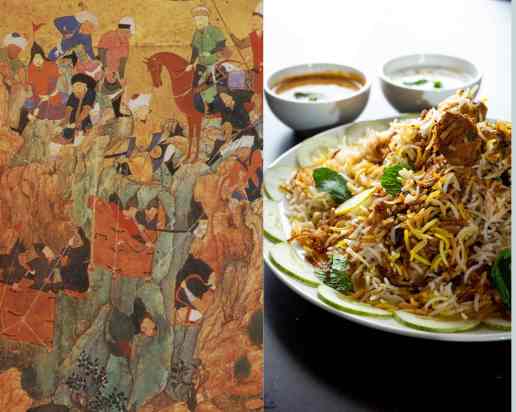
Arab Traders and the Malabar Connection:
Another intriguing story revolves around the southern Malabar coast of India where the Arabian Sea’s waves whispered tales of trade and cultural exchange. It was here that Arab traders, frequent visitors to the region, left their mark on Indian cuisine. Records from as early as 2 A.D. reveal a rice dish known as “Oon Soru” in Tamil literature, serving as a source of nourishment for military warriors. This dish consisted of rice, ghee, meat, turmeric, coriander, pepper, and bay leaf. It is believed that the Arab traders introduced their own version of rice and meat preparations, laying the foundation for the biryani we know today.
Evolution and Regional Variations:
The biryani found favor among the royalty of India, with the Nizams of Hyderabad and the Nawabs of Lucknow playing significant roles in its popularity. Their royal kitchens were known for their culinary finesse, and their chefs were revered for their expertise in crafting exquisite biryanis. The Nizams of Hyderabad introduced the iconic Hyderabadi biryani, while the Nawabs of Lucknow elevated the art of biryani-making with their fragrant and flavorful Awadhi biryanis.
As time went on, biriyani adapted to the diverse regional tastes and preferences across India, giving rise to a myriad of flavors and styles. The Awadhi biryani from Lucknow, for example, is known for its fragrant basmati rice layered with succulent meat, saffron, and a plethora of spices. Hyderabad, the city of Nizams, gave birth to the iconic Hyderabadi biryani, characterized by its fusion of Persian and Telugu influences, featuring rich flavors and tender meat.
In South India, the Chettinad biryani is celebrated for its fiery spices and robust flavors, while the Malabar biriyani from Kerala boasts a unique blend of indigenous spices and the coastal region’s fresh seafood. Kolkata, the cultural capital of West Bengal, offers the Kolkata biryani, featuring fragrant rice infused with a subtle blend of spices and succulent pieces of meat.
The Muslim hubs of Delhi (Mughlai cuisine), Rampur, Lucknow (Awadhi cuisine), and other minor principalities in North India gave rise to many types of biryani. However, some people think that the dish came from Muslim-populated areas of Tamil Nadu (Ambur, Thanjavur, Chettinad, Salem, and Dindigul), Kerala (Malabar), Telangana, and Karnataka (Bhatkal).
The Artistry of Biryani:
Preparing the perfect biryani requires finesse and a deep understanding of flavors. Traditionally, the dum pukht method, meaning “slow breathing oven” in Persian, was employed. This technique involves layering the marinated meat, partially cooked rice, and a symphony of spices in a pot, which is then sealed with dough. Slowly cooked over charcoal, allowing the steam to work its magic, the biryani emerges as a masterpiece. The steam-infused rice becomes a canvas for the tender meat to melt in its own juices, infusing every grain with delectable flavors.
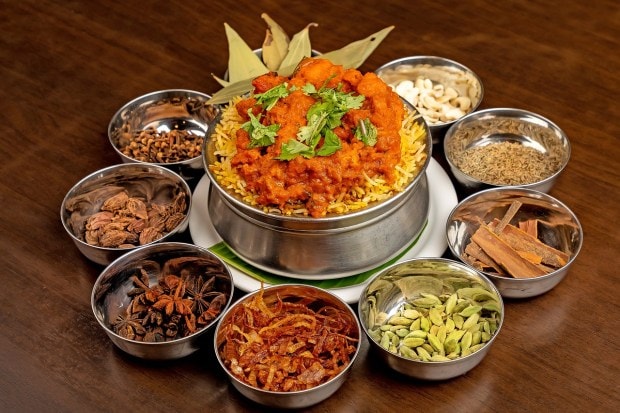
The Best Spots in India for Biryani:
Lucknow, Uttar Pradesh: Known as the “City of Nawabs,” Lucknow is renowned for its Awadhi biryani. Head to iconic establishments like Tunday Kababi and Wahid Biryani for an authentic culinary experience.
Delhi: Some spots in Delhi like Jama Masjid will serve you the best biryani you ever had.

Hyderabad, Telangana: A trip to the “City of Pearls” is incomplete without savoring the Hyderabadi biryani. Paradise Biryani and Shah Ghouse Cafe are two legendary spots that offer delectable renditions of this classic dish.
Chettinad, Tamil Nadu: Explore the small towns of Karaikudi and Madurai to indulge in the fiery Chettinad biryani. Sri Krishna Vilas and Amsavalli Anandha Vilas are renowned eateries that serve up authentic flavors.
Malabar, Kerala: The Malabar biriyani is a culinary delight that combines aromatic rice, fragrant spices, and fresh seafood. Make your way to Calicut and visit Paragon Restaurant or Rahmath Hotel for an unforgettable experience.
Kolkata, West Bengal: The Kolkata biryani, with its subtle flavors and tender meat, can be enjoyed at famous establishments like Arsalan and Shiraz Golden Restaurant.
As you embark on this flavorful adventure, let the tale of biryani unfold before your senses. From its exotic origins to the grand kitchens of Indian royalty, biryani has journeyed through time, captivating hearts and taste buds along the way. So, dear food enthusiast, on this Biriyani Day, let us celebrate the rich heritage and irresistible allure of biryani. Indulge in the symphony of flavors, savor each morsel, and revel in the culinary legacy that has been passed down through generations. Let biryani, with its magical blend of spices and fragrant rice, transport you to a world where taste knows no boundaries.
